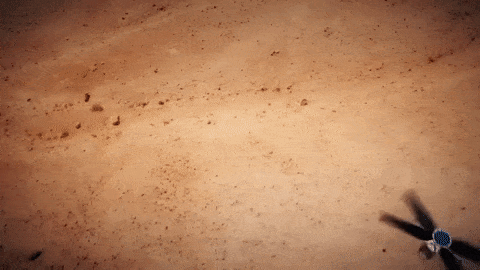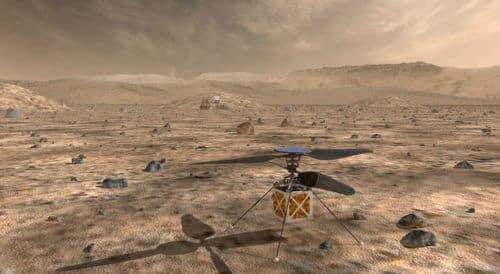The result of four years of planning, experimentation and redesign by the team weighs just under 1.8 kg. Its body is about the size of a softball, and its two counter-rotating blades will cut through the thin Martian atmosphere at nearly 3,000 rpm—about 10 times the speed of a helicopter on Earth.

Image: NASA/JPL-Caltech
The Mars copter, any small autonomous rotorcraft, will travel with NASA's vehicle mission Mars 2020, whose launch is currently scheduled for July 2020, to demonstrate the viability and potential of heavier-than-air craft on the Red Planet.
"NASA has a proud history of firsts," said NASA Administrator Jim Bridenstine. "The idea of a helicopter flying in the sky of another planet is exciting. The Mars helicopter holds great promise for our future science, discovery and research missions to Mars."
The Mars lander, which began in August 2013 as a technology development project at the Jet Propulsion Laboratory (JPL), had to prove that big things can come in small packages. The result of four years of planning, experimentation and redesign by the team weighs just under 1.8 kg. Its body is about the size of a softball, and its two counter-rotating blades will cut through the thin Martian atmosphere at nearly 3,000 rpm—about 10 times the speed of a helicopter on Earth.
The helicopter also has built-in capabilities that are necessary for operation on Mars, including solar cells to charge its lithium-ion batteries, and a heating mechanism to keep it warm during the cold Martian nights. But before the helicopter can fly on Mars it has to get there. It will do so attached to the ventral pelvis of the Mars 2020 vehicle.

“The record altitude for a helicopter flying here on Earth is about 40,000 feet. The atmosphere on Mars is only one percent of Earth's atmosphere, so when our helicopter is on the surface of Mars, it will already be at the Earth equivalent of 100,000 feet," said Mimi Ong, director of the Mars Helicopter Project at JPL. "To allow it to fly in this low atmospheric density, we had to carefully check everything, make it as light as possible and at the same time as strong and powerful as possible."
Once the vehicle is on the surface of the planet, a suitable place will be found to unload the helicopter from it and place it on the ground. The vehicle will be moved away from the helicopter to a safe distance from which it will transmit commands. After its batteries are charged and a lot of testing is done, controllers on Earth will give the Mars helicopter the command to take off on its first autonomous flight in history.
"We don't have a pilot and Earth will be a few light minutes away, so there is no possibility of using a steering rod in this mission in real time," Ong said. "Instead we have an autonomous capability that can receive and interpret commands from the ground, and then fly the mission on its own."
The full series of test flights will last 30 days and will include up to five flights with increasing flight distances, up to several hundred meters, and longer durations up to 90 seconds, over a period of time. In its first flight, the helicopter will make a short vertical ascent to ten feet (three meters), and will hover there for about 30 seconds.
As a technology demonstration, the Mars helicopter is considered a high-risk, high-probability project. If it doesn't work, it won't affect the Mars 2020 mission. If it does work, helicopters could have a real future as scouts and landing craft to reach places inaccessible by ground traffic.
"Being able to clearly see what's behind the next hill is essential for future rangers," Zorbuchen said. "We already have great views of Mars from the surface and from orbit. With the added dimension of a bird's eye view using the Marscopter, we can only imagine what future missions will achieve."
The 2020 Mars mission will be launched on a United Launch Alliance (ULA) Atlas 5 launcher from Space Launch Complex 41 at Cape Canaveral Air Force Base in Florida, and is expected to reach Mars in February 2021.
The vehicle will perform geological assessments of its Martian landing site, determine the habitability of the environment, search for signs of ancient Martian life, and assess natural resources and hazards for future human explorers. The scientists will use instruments on the vehicle to identify and collect samples of rocks and soil, package them in sealed tubes and leave them on the planet's surface for potential return to Earth on a future Mars mission.
For information on the NASA website
More of the topic in Hayadan:

6 תגובות
I'm interested in how much electricity it can store in the batteries and how much engine power is needed to hover in a thin atmosphere. What is the size of the solar cells and their weight?
The regulations for the use of the NASA website allow one-to-one publication, in our case a translation. If everyone knew English and could read directly on the NASA website, there would be no need for the science website, because it would not have a million readers a year.
Don't want to sound bad or anything.. but this is a one-to-one translation of what was said by NASA
"Being able to clearly see what's behind the next hill is essential for future explorers"
And is it not possible to make the same observation with the help of satellites that are in low orbit around Mars?
Sending a manned or unmanned helicopter or plane to Mars is a purely technological achievement. If there were suitable conditions for the existence of life on the surface of Mars, then they would also have appeared there since the existence of the solar system about five billion years ago when it was formed. The atmosphere of Mars is very thin (about 25 km) because its mass is about half of the mass of the Earth and therefore the weak gravity of Mars is not able to maintain a thicker atmosphere. Because of the thin atmosphere of Mars and because of its distance from the sun (220 million km compared to the Earth's 150 million km), the highest temperature on its surface is minus 100 degrees Celsius and it also drops to minus 200 degrees. Therefore, any thought of transferring a population of animals and/or humans from Earth to Mars is complete nonsense in tomato juice.
Because most Americans are ignorant and you have to explain to them basic dimensions according to the size of products they know, in the USA they will write the size of a "softball" and not dimensions in inches or cm. In Israel, the majority will understand measurements in cm better. So you should translate the measurements.
Regarding the height in feet, in one place the number was translated to meters, it would have been useful to translate everywhere. The USA, Liberia and Burma are the only countries (there are a few other small islands) that still do not require the use of the metric measurement system by law, although in Liberia and Burma the metric system is the most common.
In the USA, many bodies have switched to the metric system, such as the federal government (with all its affiliates such as NASA), the car manufacturers, the medical and scientific system, and most of the groceries sold in food stores are marked according to the law in metric measurements in addition to the old marking.
I suggest to follow the translation of all measurements in articles translated to the metric system. It is possible to exclude the height of planes with an addition in parentheses of the height in feet (the measurement "foot" is not really defined, as well as "finger") because it is still used in aviation, unfortunately.